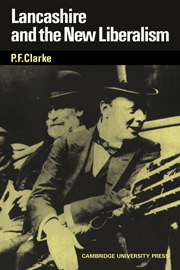Book contents
PART FOUR - THE RECONSTITUTION OF LIBERAL LANCASHIRE
Published online by Cambridge University Press: 23 November 2009
Summary
The Liberal revival gave evidence of its scale in 1906 and of its durability in 1910. In one sense this represented the triumph of the progressive idea. The basis of progressive policy, as elaborated after 1906, was formulated in the 1890s, and the career of C. P. Scott is of particular significance here. Scott's efforts in Manchester politics did not bear fruit in the short term; but he and L. T. Hobhouse were educating their party. The Boer War had the effect of reconciling Gladstonians, collectivists and organised labour – three elements in the progressive coalition which ruled Britain from 1905. In the era of Liberal success Scott found, first in Churchill, then in Lloyd George, sympathetic exponents of his kind of views. Policy was one indispensable condition of Liberal revival: organisation was another. Here the Liberals were less happily placed, principally because they lacked a ready source of funds. But they made the best of what they had through a process of centralisation, which was one reflection of the growing importance of national as against local influences in politics. This tendency can be seen too in the matter of candidates. In ‘Tory Lancashire’ local candidates and local issues had been the norm. But most of the progressive M.P.s who took over from them were professional politicians deployed on a national basis.
- Type
- Chapter
- Information
- Lancashire and the New Liberalism , pp. 151 - 152Publisher: Cambridge University PressPrint publication year: 1971



